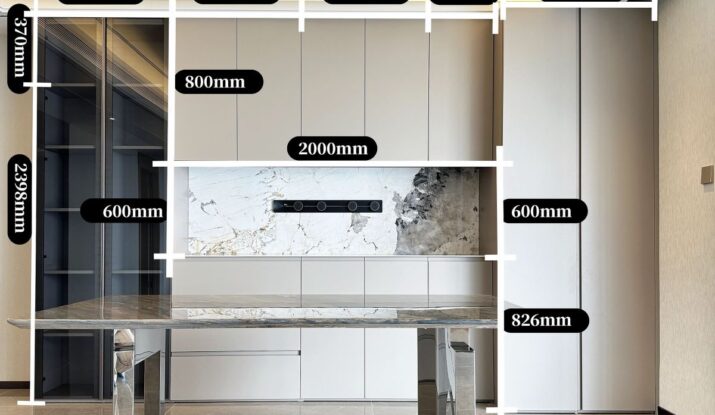Every kitchen is different; some have low ceilings, plumbing, gas lines, or special layouts. But don’t stress! Our cabinet measurement guide will show you exactly how to measure everything the right way so your new cabinets fit perfectly the first time.
Taking measurements for cabinets might not be the most exciting part of cabinet selection, yet it remains the most critical aspect. Proper measurements will protect you from both painful mistakes and unnecessarily high costs when you need cabinets.
By the end of this cabinet measurement guide, you’ll know exactly how to measure wall cabinets, base cabinets, and even tall cabinets for pantry storage. Let’s get started!
Why Measuring Right Makes All the Difference
Nobody likes that surprise in the kitchen. Now imagine: you buy brand new cabinets and wait forever for them to arrive, only to find out they don’t fit. Total disappointment! That’s why getting your measurements perfect is so important.
Here’s what happens when you measure right:
- You Save Money (And Your Sanity!)
Wrong measurements = big problems. You might end up with cabinets that don’t fit or appliances that won’t slide in. Do it right the first time and you’ll avoid expensive mistakes. - Everything Fits Like It Should
Your fridge, oven, and dishwasher need space to breathe. Good measurements mean your cabinets won’t block windows or leave weird empty gaps. - You Get More Storage Space
Ever open a cabinet and think, “This could be so much more useful?” The right measurements help you use every inch smartly, perfect for all your existing kitchen stuff. - It Works With Your Kitchen’s Special Features
Most kitchens aren’t cookie-cutter perfect. Maybe your ceiling is a little low or your pipes stick out funny. Good measurements help you work with these things instead of fighting them.
It may take a few extra minutes to measure carefully now, but it will save you from some major headaches later. Follow our cabinet measurement guide and thank us later.
Grab These Tools for the Right Cabinet Dimensions
Okay, let’s get your toolbox ready! You don’t need anything fancy, but having the right tools will make measuring way easier. Our cabinet measurement guide mentions everything you’ll need to have:
- Tape Measure: Your new best friend! This is the most important tool for getting those numbers right.
- Level – Helps make sure your cabinets won’t be crooked (because nobody wants leaning cabinets!).
- Pencil and Paper: For writing down all your measurements. If you’re techy, you can use your phone instead.
- Laser Measure (If You Have One): Not necessary, but super handy for getting super precise measurements.
- Stud Finder: Super important if you’re hanging wall cabinets. It helps find the strong parts of your wall so your cabinetry stays up safely.
Pro Tip: Grab a helper, too! Some measurements are easier with two people, plus it’s more fun.
Now that you’ve got your tools, let’s learn how to measure everything!
Step-by-Step Cabinet Measurement Guide
Let’s break this down step by step so you can measure your cabinets without any stress. We’ll go through each type of cabinet option one by one.
A. Measuring Upper Cabinets (Wall Cabinets)
- How Tall?
- Measure from your countertop up to where you want the cabinet to end
- Most are about 30 to 42 inches tall, but check for lights or vents in the way!
- How Wide?
- Measure the empty wall space where they’ll go
- Leave a tiny gap (think the thickness of two pennies) so they fit nicely
- How Deep?
- Standard is 12 inches deep (about the length of a ruler)
- Want deeper shelves? Measure your biggest plates to be sure they’ll fit
B. Measuring Base Cabinets (Under the Counter)
- Height Check:
- Without the counter, they’re usually 34.5 inches tall
- Add your counter thickness (typically 1.5 inches) for total height
- Width Matters:
- Measure carefully near appliances, fridge, and dishwasher spaces are tricky!
- Leave a little extra room so cabinet doors don’t scrape when opening
- Depth Details:
- The standard is 24 inches deep
- Got pull-out shelves? Measure them too!
C. Measuring Tall Cabinets (Like Pantries)
- Full Height:
- Measure floor to ceiling
- Most are about 7-8 feet tall
- Floor Check:
- Are your floors perfectly flat? Probably not!
- Check both sides – sometimes one side is slightly higher
D. Don’t Forget These!
- Existing Cabinets: Measure them before removing if you’re replacing
- Hidden Stuff: Look for pipes, wires, or vents that might be in the way
- Just Doors/Drawers? Measure their exact size if you’re only replacing those parts
Smart Tip: Take pictures of your measurements with your phone – it helps you remember which number goes where!
Standard Kitchen Cabinet Sizes
Cabinets come in industry-standard sizes that work in most kitchen walls. Here’s the basic breakdown:
- Standard Wall Cabinets (Upper Cabinets):
- Depth (How far they stick out): 12-24 inches
- Height: 30-42 inches
- Base Cabinets (Under Counter):
- Depth: 24 inches
- Height: 34.5 inches (without the countertop)
- Tall Cabinets (Like Pantries):
- Height: 84-96 inches (7-8 feet tall)
Why This Matters:
These are the most common sizes most cabinets come in, and you’ll be able to find replacements or matching pieces later if you stick to these sizes.
Common Measuring Mistakes (And How to Avoid Them)

Even pros mess up sometimes! Here’s what to watch out for:
- Forgetting About Appliances
- Your fridge, stove, and sink need space!
- Always measure around them so cabinets don’t block doors or handles.
- Ignoring Door Styles & Cabinet Fronts
- Some doors (like ones with handles) need extra room to open.
- Measure how far they stick out when open.
- Skipping Ceiling & Floor Checks
- Not all ceilings are the same height everywhere.
- Floors can be uneven—measure both sides!
Quick Fix:
Double-check every measurement before ordering. It’s way easier to fix a number now than to return cabinets later!
Cabinet Measurement Guide FAQs – Simple Answers to Common Questions
Got questions? We’ve got answers! Here are the most common things people wonder when measuring cabinets:
Q1: How do I measure if I’m replacing current cabinets?
Easy! Just measure your current cabinets:
Width (side to side)
Depth (how far they stick out)
Height (top to bottom)
Also, take note of:
Door style (do they swing open or slide?)
Drawer sizes (so new ones fit the same way)
Q2: How high should upper cabinets be above the counter?
Most are 18 inches above the countertop, but check two things:
Your ceiling height (got low ceilings? You might need to adjust)
Your own height (can you reach the bottom shelf comfortably?)
Q3: How much space do appliances need?
Leave a little “breathing room”:
Fridge: ½ inch on each side (so the door opens smoothly)
Dishwasher & stove: ¼ inch gap (so they fit without scraping)
Q4: Can I just put new cabinets over my old ones?
Nope! It might seem faster, but:
You won’t get accurate measurements
It makes your kitchen space smaller
Old cabinets might not be sturdy enough
Always remove old ones first!
Q5: How do I measure tricky corner cabinets?
Corners are weird! Here’s how:
Measure diagonally from wall to wall
Decide if you want a Lazy Susan (spinning shelf) or pull-out shelves
Remember: Corner cabinets often need special sizes
Pro Tip: Take pictures of your measurements and label them (like “left corner cabinet”) so you don’t get confused later!
Still have questions? Just ask – we’re happy to help!
Conclusion
You’ve just learned how to calculate square feet of cabinets and everything else needed to measure your kitchen correctly in this cabinet measurement guide– congratulations! Before you start shopping for your dream cabinets, let’s recap why these measurements matter so much:
- Precision saves money and frustration. A few careful measurements now prevent costly mistakes later
- Standard sizes simplify your project. Knowing accurate dimensions helps with planning
- Your kitchen’s unique features matter. Accounting for appliances, plumbing, and layout ensures everything fits beautifully
At Dr. Cabinet, we know how exciting (and overwhelming) kitchen upgrades can be. That’s why we created this Cabinet Measurement Guide to give you the confidence to get it right the first time.
One Last Pro Tip: Have someone else review your measurements before finalizing your order. A fresh pair of eyes often catches small mistakes you might have missed!
Start your transformation today at Dr. Cabinet, where perfect fit meets exceptional quality.



